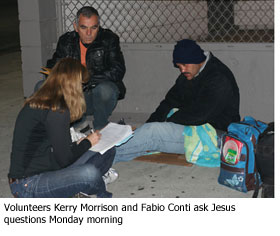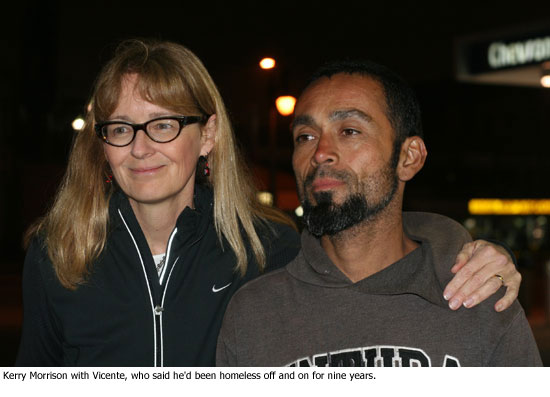Embracing the Hollywood homeless
April 29, 2010
“I’m Kerry, what’s your name?”
It’s 4:30 a.m. on Monday, and Kerry Morrison, a Hancock Park mother of two teens, stops a limping man named Vicente at a Chevron station on Highland Avenue in Hollywood. The tall woman with the clipboard is calm, friendly and matter of fact.
“I want to ask you some questions about being homeless.”
With a bit of sweet talk—and a free meal card from Subway—Morrison cajoles Vicente to share his saga of street life, which includes frostbite, substance abuse and jail time.
“I’m so happy that this is finally happening,” Morrison says walking down Hollywood Boulevard after speaking to Vicente. “We need to do everything we can to humanize the homeless.”
Morrison is one of more than 50 volunteers collecting data for the Hollywood Homeless Registry, a three-night survey that marks the first detailed study of the full homeless population in that area.
She’s also the driving force behind the whole effort.
Morrison, 54, is executive director of the Hollywood Entertainment Business Improvement District, a band of 250 business owners working to improve economic and quality of life conditions on Hollywood Boulevard. She’s worked for more than two years to bring together non-profits, government and business groups in a coalition called Hollywood 4WRD to help end the neighborhood’s longstanding homeless problem.
“Kerry’s been the hub,” says Fabio Conti, owner of Fabiolus Café on Sunset Boulevard who brought jackets and blankets to hand out to the homeless. “She’s the happiest lady in the world when she’s talking to these people.”
Beth Sandor, field director in Los Angeles for Common Ground, a homeless advocacy group that developed the four-page “vulnerability index” questionnaire used in the survey, praised Morrison as “one of the most committed business leaders in Los Angeles on the issue of ending homelessness.”
The purpose of Common Ground’s 38-question survey is to identify those most likely to die on the streets and provide them with housing and comprehensive medical, mental health and social services. The questions focus on factors such as the number of recent emergency-room visits, jail stints, substance abuse problems and chronic illnesses.
The vulnerability index was instrumental in the creation of Project 50, the groundbreaking program launched more than two years ago at the urging of Supervisor Zev Yaroslavsky that has housed and provided services for 66 once-chronically homeless individuals on L.A.’s Skid Row. That program has now been replicated in other parts of Yaroslavsky’s district, including Venice, Santa Monica and Van Nuys.
 Before the pre-dawn launch of the Hollywood effort, the supervisor spoke to the survey volunteers and then headed onto the streets with them. By Wednesday afternoon, questionnaires had been completed for 257 homeless men. Another 70 declined to participate. More than 82 percent of the Hollywood homeless were men, whose ages ranged from late teens to a newly-homeless man of 80.
Before the pre-dawn launch of the Hollywood effort, the supervisor spoke to the survey volunteers and then headed onto the streets with them. By Wednesday afternoon, questionnaires had been completed for 257 homeless men. Another 70 declined to participate. More than 82 percent of the Hollywood homeless were men, whose ages ranged from late teens to a newly-homeless man of 80.
Morrison once seemed like an unlikely champion for Hollywood’s homeless. Raised in a middle-class Denver suburb, the daughter of a steel salesman, Morrison worked in government affairs at the California Association of Realtors for over a decade after moving to L.A. in the late 1970s.
Jolted by the 1992 riots to aid in the city’s recovery, she became executive director of the new Hollywood business improvement district, and came face to face with the neighborhood’s homeless problem.
As Hollywood worked to gentrify, some business owners—and many residents—hoped the solution to the homeless problem was simply to move the street people out. Morrison disagreed and vowed to educate herself and her board members.
She came to prefer the “permanent supportive housing” model, in which individuals are given apartments along with a variety of services to help them lead more stable and healthy lives. Her view was far from prevalent. When a 60-unit project was proposed for Gower Avenue in 2006, the backlash stunned Morrison.
“The community vitriol was mind-boggling,” she recalls. To this day, the project remains on hold.
In 2008, Morrison invited then-President Bush’s homeless czar, Philip Mangano, to make the case for permanent supportive housing as a better solution than shelters for the urban homeless. Later, she organized a field trip to visit Step Up on Second’s permanent supportive housing facility in Santa Monica. She put together a “snapshot” count of Hollywood’s homeless that year that found about 500 people living on the streets.
As part of her education, Morrison also realized she needed to get closer to her homeless neighbors. “I made a commitment to start talking to homeless people,” she recalls. “I had to conquer my own fears.”
She befriended local street people, including a mentally-ill man named Torrey who slept along the Walk of Fame until Morrison pushed for his hospitalization. He now lives in a Hollywood motel, although he declines to take his medication, Morrison says.
The experience taught her that it was essential for business owners and the public to see the homeless as people with individual stories.
That’s why the Hollywood team will take the unusual step of announcing the names and profiles of the 10 most vulnerable among Hollywood’s homeless at a news conference at 2 p.m. Friday at the Los Angeles Film School, 6353 Sunset Boulevard.
“We know that getting housing for them won’t happen unless we put the names and faces to the issue,” Morrison says.
The problem, Morrison notes, is that there aren’t yet apartments and housing in place for these individuals. Step Up on Second has bought a motel on Vine Street for permanent supportive homeless housing, but construction has yet to get underway. A committee is working to identify other housing possibilities, Morrison says.
She hopes publicity from the survey will lead to housing breakthroughs. She notes happily that Los Angeles City Councilman Tom LaBonge and two staffers joined the survey Tuesday morning and hopes he and other city leaders will come through with help on the housing front.
“The survey is an essential step,” says Morrison. “I’m incredibly optimistic that Hollywood can be a community that can embrace the homeless.”
Posted 4-29-10
Read related story
On his blog, Zev writes about his night with the Hollywood homeless.













 405 bridge work causes a stink
405 bridge work causes a stink

